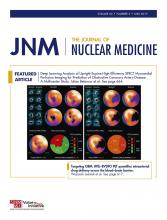Discussions with leaders: JNM editor-in-chief Johannes Czernin continues a series of interviews with leaders in nuclear and molecular imaging and therapy with a conversation with Markus Schwaiger.
Page 573
Reporting systems for PET theranostics: Werner and colleagues introduce current framework systems for prostate-specific membrane antigen–targeted and somatostatin receptor–targeted PET imaging and provide an overview of advantages, limitations, and potential future applications.
Page 577
Future of continuing certification: Segall reports on the draft findings of an independent American Board of Medical Sciences commission on replacing maintenance of certification with a new process.
Page 585
Bioconjugation methods in radiosynthesis: Fay and Holland provide perspective on the potential impact of new alternative bioconjugation strategies on radiotracer design and describe the potential of these new methods to expand the range of PET and other imaging.
Page 587
PET/CT and survival in HNSCC: Rohde and colleagues determine whether staging with 18F-FDG PET/CT better predicts survival in patients with recurrent head and neck squamous cell carcinoma than chest x-ray plus head and neck MRI or chest CT plus MRI.
Page 592
Quantitative metrics repeatability in NSCLC: Zhuang and colleagues investigate the variability and test–retest ratios of metabolically active tumor volumes and other measurements in non–small cell lung cancer using 18F-FDG PET/CT with different processing and timing variables.
Page 600
PET test–retest reproducibility: Kurland and colleagues describe a multicenter qualification process using NIST–traceable reference sources for scanners and dose calibrators, and report on patient and 18F-FDG PET/CT imaging protocols assessing SUV in test–retest studies.
Page 608
Brain access of monoclonal antibodies: Veldhuijzen van Zanten and colleagues offer perspective on current challenges in assessment of the passage of therapeutic monoclonal antibodies across the intact blood–brain barrier and preview a related article in this issue of JNM.
Page 615
89Zr-BVDFO PET: Lesniak and colleagues demonstrate a method for quantification of intraarterial delivery of bevacizumab into the brain across an osmotically opened blood–brain barrier using 89Zr-BVDFO PET, with implications for more effective and personalized glioblastoma multiforme treatment.
Page 617
High-specific-activity 131I-MIBG therapy: Pryma and colleagues report on a multicenter, phase 2 trial evaluating the efficacy and safety of high-specific-activity 131I-MIBG in patients with advanced pheochromocytoma/paraganglioma.
Page 623
Adjuvant radioiodine therapy in DTC: Bacher and colleagues examine whether previous findings on patient preparation methods, thyroid uptake, and effective half-life in thyroid cancer are reproducible in a protocol with a short interval between surgery and adjuvant radioiodine therapy.
Page 631
131I detection in public places: Bikas and colleagues discuss results of a survey on the frequency of detection of patients after 131I treatment, range of public facilities, methods of security management of events, and types of physician documentation for patients.
Page 638
177Lu-PSMA rechallenge in prostate cancer: Gafita and colleagues retrospectively evaluate the feasibility of rechallenge 177Lu-prostate-specific membrane antigen radioligand therapy in patients with prostate cancer.
Page 644
PSMA-targeted α-therapy response: Kelly and colleagues assess in a murine model the albumin-binding prostate-specific membrane antigen–targeting ligand RPS-074 in an LNCaP xenograft model and its potential for treatment in metastatic castration-resistant prostate cancer.
Page 649
PSMA ligands with improved tumor uptake: Kelly and colleagues use structural modifications to increase the tumor-to-kidney ratio of the trifunctional radioligand RPS-063 through increased albumin binding, tumor uptake, and reduction of kidney activity.
Page 656
Deep learning analysis of MPI D-SPECT: Betancur and colleagues explore prediction of obstructive disease from combined analysis of semiupright and supine stress myocardial perfusion imaging with deep learning and compare results with those from standard combined total perfusion deficit.
Page 664
Cerebral metabolism and gait freezing: Mitchell and colleagues test whether cognitive corticobasal ganglia–thalamocortical circuitry is impaired and whether alternate neural circuits are used for complex gait in Parkinson disease with freezing of gait.
Page 671
Phantom for PET brain imaging: Fahey and colleagues from a multicenter pediatric consortium report on scanning of a phantom developed by the SNMMI Clinical Trials Network for validation of brain PET studies in clinical trials.
Page 677
P2X7 PET ligand 18F-JNJ-64413739: Koole and colleagues describe the clinical qualification of this P2X7-specific PET ligand in healthy volunteers, including whole-body dosimetry, kinetic modeling, test–retest variability, and blocking by the P2X7 antagonist JNJ-54175446.
Page 683
Automated 89Zr-mAb labeling: Poot and colleagues develop a simple, fully automated, good manufacturing practice–compliant production procedure for 89Zr labeling of monoclonal antibodies.
Page 691
89ZrCl4 in immuno-PET radiochemistry: Pandya and colleagues evaluate the use of 89Zr-chloride in radiolabeling of monoclonal antibodies conjugated with desferrioxamine B, describe its effects on radiopharmaceutical reactivity toward antigens, and offer guidance on ensuring long-term stability and purity.
Page 696
Cerenkov radiation activation in cancer treatment: Kavadiya and Biswas describe a mathematic model that integrates Cerenkov physics, light interaction with matter, and photocatalytic reaction engineering for use with activation of nanoparticles to control tumor growth.
Page 702
Shielded PET in radionuclide therapy: Mellhammar and colleagues detail a method for preserving preclinical PET quality during intratherapeutic imaging in radionuclide therapy with rose metal shielding to reduce photon flux.
Page 710
- © 2019 by the Society of Nuclear Medicine and Molecular Imaging.







